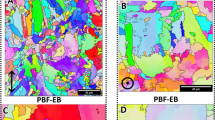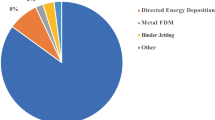Abstract
Approaches for in-situ monitoring elemental composition in the working zone during additive manufacturing (AM) with directed energy deposition are relatively underdeveloped and especially needed for processes with multiple powder delivery feeds, such as laser-based directed energy deposition. In this study, Laser-Induced Breakdown Spectroscopy (LIBS) was explored for monitoring elemental composition of an AM-sintered graded Fe-Ni alloy. Fe and Ni powder feeds were varied during Fe-Ni alloy sample building, and LIBS was used to determine gradient alloy composition, which was also verified by mapping Fe and Ni gradients along the sample build direction with an Energy-Dispersive X-ray Spectroscopy (EDS) technique. An integrated experimental and modeling approach presented in this work rapidly fits Fe and Ni peak LIBS emission data by using a physics-informed emission peak identification algorithm based on an atomic emission spectrum simulation to predict peak occurrences, locations, and significant intensities. The approach allows to considerably reduce the computational time needed for peak identification, labeling, and fitting in experimental recorded spectroscopic data. The performed LIBS experimental measurements using this approach demonstrated a 5-Hz composition analysis data rate. Changes in the Fe and Ni peak intensity areas of the compositionally graded sample were correlated to the externally measured composition using EDS, which yielded a good correlation between LIBS and EDS-measured data. The developed approaches indicate directions for obtaining elemental composition data at speeds comparable with AM process control parameter variations, striding towards in-situ non-invasive composition monitoring and closed-loop process control implementations.






Similar content being viewed by others
Data Availability
Not applicable.
Code availability
Not applicable.
References
Bourell DL, Beaman JJ, Wohlers T (2020) History and evolution of additive manufacturing. In: Bourell DL, Frazier W, Kuhn H, Seifi M (eds) Additive Manufacturing Processes. ASM International, p 1
Dass A, Moridi A (2019) State of the art in directed energy deposition: from additive manufacturing to materials design. Coatings 9:418. https://doi.org/10.3390/coatings9070418
Sames WJ, List FA, Pannala S, Dehoff RR, Babu SS (2016) The metallurgy and processing science of metal additive manufacturing. Int Mater Rev 61:315–360. https://doi.org/10.1080/09506608.2015.1116649
Frazier WE (2014) Metal additive manufacturing: a review. J Mater Eng Perform 23:1917–1928. https://doi.org/10.1007/s11665-014-0958-z
Melchels FP, Feijen J, Grijpma DW (2010) A review on stereolithography and its applications in biomedical engineering. Biomaterials 31:6121–6130. https://doi.org/10.1016/j.biomaterials.2010.04.050
Busachi A, Erkoyuncu J, Colegrove P, Martina F, Watts C, Drake R (2017) A review of additive manufacturing technology and cost estimation techniques for the defense sector. CIRP J Manuf Sci Technol 19:117–128. https://doi.org/10.1016/j.cirpj.2017.07.001
Gisario A, Kazarian M, Martina F, Mehrpouya M (2019) Metal additive manufacturing in the commercial aviation industry: a review. J Manuf Syst 53:124–149. https://doi.org/10.1016/j.jmsy.2019.08.005
Diegel O, Nordin A, Motte D (2019) Additive manufacturing technologies. In: A Practical Guide to Design for Additive Manufacturing. Springer, Singapore, pp 19–39
Feenstra DR, Banerjee R, Fraser HL, Huang A, Molotnikov A, Birbilis N (2021) Critical review of the state of the art in multi-material fabrication via directed energy deposition. Curr Opinion Solid State Mater Sci 25. https://doi.org/10.1016/j.cossms.2021.100924
Gasser A, Backes G, Kelbassa I, Weisheit A, Wissenbach K (2010) Laser metal deposition (LMD) and selective laser melting (SLM) in turbo-engine applications. Laser Tech J 2:58–63. https://doi.org/10.1002/latj.201090029
Saboori A, Gallo D, Biamino S, Fino P, Lombardi M (2017) An overview of additive manufacturing of titanium components by directed energy deposition: microstructure and mechanical properties. Appl Sci 7(9):883. https://doi.org/10.3390/app7090883
Lima DD et al (2017) Laser additive processing of a functionally graded internal fracture fixation plate. Mater Des 130:8–15. https://doi.org/10.1016/j.matdes.2017.05.034
Zhang C et al (2019) Additive manufacturing of functionally graded materials: a review. Mater Sci Eng A 764. https://doi.org/10.1016/j.msea.2019.138209
Everton SK, Hirsch M, Stravroulakis P, Leach RK, Clare AT (2016) Review of in-situ process monitoring and in-situ metrology for metal additive manufacturing. Mater Des 95:431–445. https://doi.org/10.1016/j.matdes.2016.01.099
Tapia G, Elwany A (2014) A review on process monitoring and control in metal-based additive manufacturing. J Manuf Sci Eng 136. https://doi.org/10.1115/1.4028540
Mazzoleni L, Caprio L, Pacher M, Demir AG, Previtali B (2018) External illumination strategies for melt pool geometry monitoring in SLM. Jom 71:928–937. https://doi.org/10.1007/s11837-018-3209-1
Furumoto T, Ueda T, Alkahari MR, Hosokawa A (2013) Investigation of laser consolidation process for metal powder by two-color pyrometer and high-speed video camera. CIRP Ann 62:223–226. https://doi.org/10.1016/j.cirp.2013.03.032
Thompson SM, Bian L, Shamsaei N, Yadollahi A (2015) An overview of direct laser deposition for additive manufacturing; part I: transport phenomena, modeling and diagnostics. Additive Manufacturing 8:36–62. https://doi.org/10.1016/j.addma.2015.07.001
Tang Z-J et al (2020) A review on in situ monitoring technology for directed energy deposition of metals. Int J Adv Manuf Technol 108:3437–3463. https://doi.org/10.1007/s00170-020-05569-3
Yan Z et al (2018) Review on thermal analysis in laser-based additive manufacturing. Opt Laser Technol 106:427–441. https://doi.org/10.1016/j.optlastec.2018.04.034
He W, Shi W, Li J, Xie H (2019) In-situ monitoring and deformation characterization by optical techniques; part I: laser-aided direct metal deposition for additive manufacturing. Opt Lasers Eng 122:74–88. https://doi.org/10.1016/j.optlaseng.2019.05.020
Spears TG, Gold SA (2016) In-process sensing in selective laser melting (SLM) additive manufacturing. Integr Mater Manuf Innov 5:16–40. https://doi.org/10.1186/s40192-016-0045-4
Grasso M, Colosimo BM (2017) Process defects and in-situ monitoring methods in metal powder bed fusion: a review. Meas Sci Technol 28. https://doi.org/10.1088/1361-6501/aa5c4f
Yang T et al (2021) A review of diagnostics methodologies for metal additive manufacturing processes and products. Materials 14:4929. https://doi.org/10.3390/ma14174929
Bartkowiak K (2010) Direct laser deposition process within spectrographic analysis in situ. Phys Procedia 5:623–629. https://doi.org/10.1016/j.phpro.2010.08.090
Shin J, Mazumder J (2016) Plasma diagnostics using optical emission spectroscopy in laser drilling process. J Laser Appl 28. https://doi.org/10.2351/1.4942631
Song L, Mazumder J (2012) Real time Cr measurement using optical emission spectroscopy during direct metal deposition process. IEEE Sensors J 12:958–964. https://doi.org/10.1109/jsen.2011.2162316
Nassar AR, Spurgeon TJ, Reutzel EW (2014) Sensing defects during directed-energy additive manufacturing of metal parts using optical emission spectroscopy. In: Proceedings of 25th Annual International Solid Freeform Fabrication Symposium; An Additive Manufacturing Conference. SFF 2014, Austin, United States, pp 278–287. Available: https://repositories.lib.utexas.edu/server/api/core/bitstreams/e487fbdf-212a-42c5-993f-bd58edc0a857/content. Accessed 20 Jan 2024
Stutzman CB, Nassar AR, Reutzel EW (2018) Multi-sensor investigations of optical emissions and their relations to directed energy deposition processes and quality. Additive Manufacturing 21:333–339. https://doi.org/10.1016/j.addma.2018.03.017
Ya W, Konuk AR, Aarts R, Pathiraj B, Huis B (2015) Spectroscopic monitoring of metallic bonding in laser metal deposition. J Mater Process Technol 220:276–284. https://doi.org/10.1016/j.jmatprotec.2015.01.026
Montazeri M, Nassar AR, Dunbar AJ, Rao P (2020) In-process monitoring of porosity in additive manufacturing using optical emission spectroscopy. IISE Trans 52:500–515. https://doi.org/10.1080/24725854.2019.1659525
Sun W, Zhang Z, Ren W, Mazumder J, Jin J (2021) In situ monitoring of optical emission spectra for microscopic pores in metal additive manufacturing. J Manuf Sci Eng 144. https://doi.org/10.1115/1.4051532
Lough CS et al (2020) In-situ optical emission spectroscopy of selective laser melting. J Manuf Process 53:336–341. https://doi.org/10.1016/j.jmapro.2020.02.016
Lednev VN et al (2019) In situ multi-elemental analysis by laser induced breakdown spectroscopy in additive manufacturing. Additive Manufact 25:64–70. https://doi.org/10.1016/j.addma.2018.10.043
Lednev VN et al (2019) In situ elemental analysis and failures detection during additive manufacturing process utilizing laser induced breakdown spectroscopy. Opt Express 27:4612–4628. https://doi.org/10.1364/OE.27.004612
Fortes FJ, Moros J, Lucena P, Cabalín LM, Laserna JJ (2013) Laser-induced breakdown spectroscopy. Anal Chem 85:640–669. https://doi.org/10.1021/ac303220r
Cremers DA, Radziemski LJ (2013) Handbook of laser-induced breakdown spectroscopy. John Wiley and Sons. https://doi.org/10.1002/9781118567371
Jolivet L, Leprince M, Moncayo S, Sorbier L, Lienemann CP, Motto-Ros V (2019) Review of the recent advances and applications of LIBS-based imaging. Spectrochim Acta B At Spectrosc 151:41–53. https://doi.org/10.1016/j.sab.2018.11.008
Lide DR (2020) CRC handbook of chemistry and physics. CRC Press
Kramida A, Olsen K, Ralchenko Y (2024) NIST LIBS database. National Institute of Standards and Technology. Available: https://physics.nist.gov/PhysRefData/ASD/LIBS/libs-form.html. Accessed 20 Jan 2024
Kramida A, Ralchenko Y, Reader J, Team NA (2023) NIST Atomic Spectra Database (version 5.11). National Institute of Standards and Technology. https://doi.org/10.18434/T4W30F
Aguilera JA, Aragón C (2007) Multi-element Saha–Boltzmann and Boltzmann plots in laser-induced plasmas. Spectrochim Acta B At Spectrosc 62:378–385. https://doi.org/10.1016/j.sab.2007.03.024
Acknowledgements
B. S., D. F., T. B., R. B., N. B. D., and A. A. V. acknowledge the use of the infrastructure of Center for Agile & Adaptive and Additive Manufacturing and Materials Research Facility at the University of North Texas.
Funding
This research is financially supported by the Army Research Laboratory Cooperative Agreement No. W911NF-19-2-0011 and by the Center for Agile & Adaptive and Additive Manufacturing through State of Texas Appropriation #190405-105-805008-220.
Author information
Authors and Affiliations
Contributions
B. S., D. F., T. B., A. N.: methodologies, investigation, formal analysis, compilation, writing original draft. R. B., B. M., K. C., N. B. D., A. A. V.: conceptualization, methodologies, project administration, supervision, resources, writing—review and editing.
Corresponding author
Ethics declarations
Ethics approval
Not applicable.
Consent to participate
Not applicable.
Consent for publication
All authors agree to the publication of the manuscript.
Conflict of interest
The authors declare no competing interests.
Additional information
Publisher’s note
Springer Nature remains neutral with regard to jurisdictional claims in published maps and institutional affiliations.
Rights and permissions
Springer Nature or its licensor (e.g. a society or other partner) holds exclusive rights to this article under a publishing agreement with the author(s) or other rightsholder(s); author self-archiving of the accepted manuscript version of this article is solely governed by the terms of such publishing agreement and applicable law.
About this article
Cite this article
Squires, B., Flannery, D., Bivens, T. et al. Laser-Induced Breakdown Spectroscopy for composition monitoring during directed energy deposition of graded Fe-Ni alloys. Int J Adv Manuf Technol (2024). https://doi.org/10.1007/s00170-024-13578-9
Received:
Accepted:
Published:
DOI: https://doi.org/10.1007/s00170-024-13578-9




